Running a business is all about understanding your company’s health, performance, and potential areas for improvement.
But how do you achieve that kind of clarity? Through business success metrics.
However, there’s a catch: There are hundreds of metrics you could use. You’ll have to select the right ones to make the best use of this potential treasure trove of information.
In this article, we look at what metrics of success are and how to choose the best ones for your company.
We also cover 16 essential business success metrics — along with formulas for how to measure them — and explore how integration with modern project management software can turn your metrics into powerful guides for growth.
What are metrics of success?
To understand success metrics, let’s first take a look at business metrics in general.
Metrics in general
Metrics are measurements used to gauge the performance, effectiveness, or outcome of a particular activity, project, or initiative. They serve as empirical data points that guide strategies, choices, and actions.
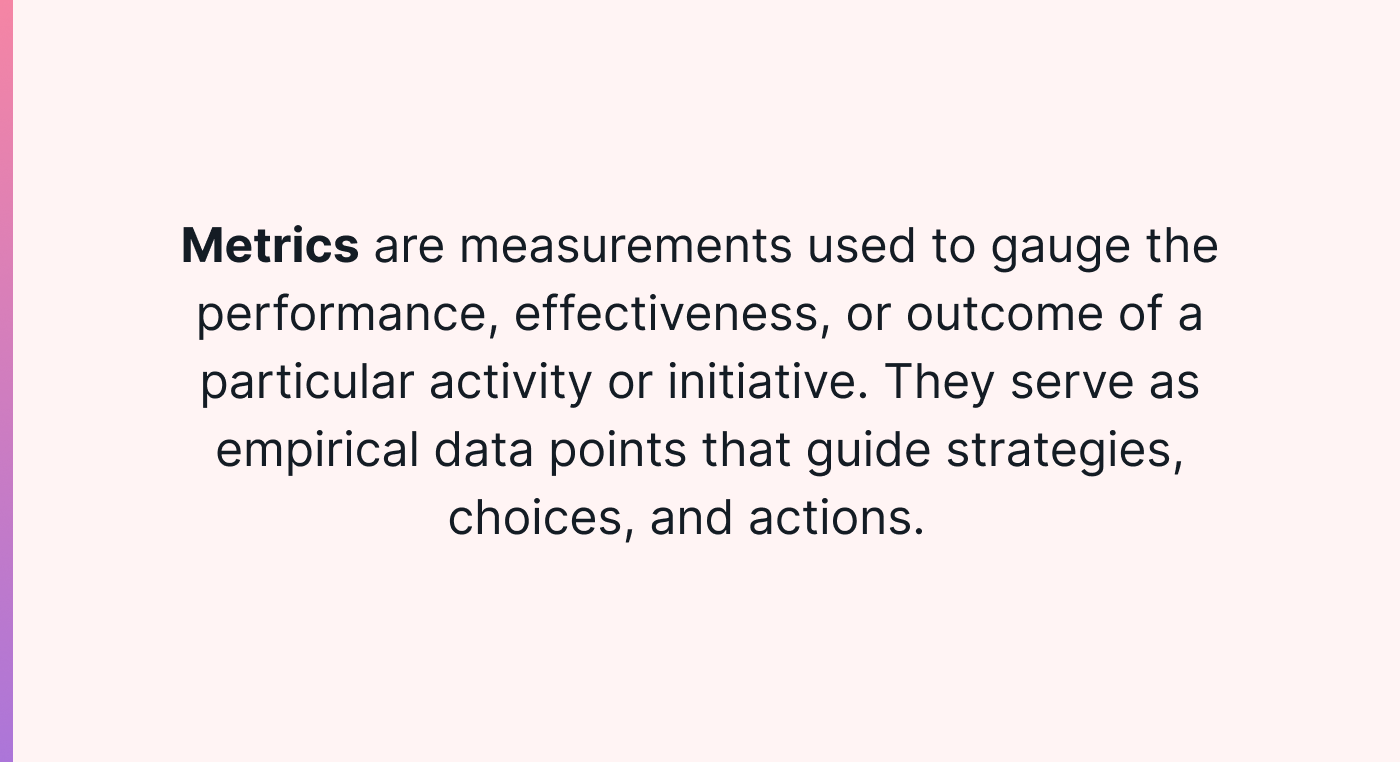 |
Metrics can be qualitative (subjective and often based on perceptions, opinions, or feelings) or quantitative (objective and can be measured or expressed numerically).
For example, the percentage of customers who stop using a company’s product or service during a defined period of time (called the company’s churn rate) is a quantitative metric. If a business starts the month with 100 customers and ends with 90, the churn rate for that month would be 10%.
An example of a qualitative metric is a collection of comments from customers who describe their experiences, feelings, or perceptions related to a product or service. For instance, they could say, “The user interface of the software feels intuitive,” or “I love the design of the product, but I wish there were more color options.”
While quantitative metrics offer a clear numerical value that can be easily measured and tracked over time, qualitative metrics provide more in-depth insights into customers’ perceptions and suggestions. These may not be easily translated into numbers, but they are just as valuable for strategic decisions and improvements.
Both types of metrics are used to evaluate the efficiency and effectiveness of operations, campaigns, and teams (performance analysis). In particular:
- They help leadership determine where to invest time, money, and labor for maximum return on investment (ROI).
- They can help identify potential pitfalls or areas of concern early on in a process.
- They can be used for a range of purposes, from evaluating a single campaign’s performance to assessing overall business health.
For any business, there’s a large number of potential metrics that can help company leaders better understand different areas of operation.
Metrics of success
Success metrics, also known as key performance indicators (KPIs), are a subset of these general metrics.
Metrics of success are more selective than general business metrics. They are specially chosen to measure performance in key areas of the company. Taken together, they indicate overall success.
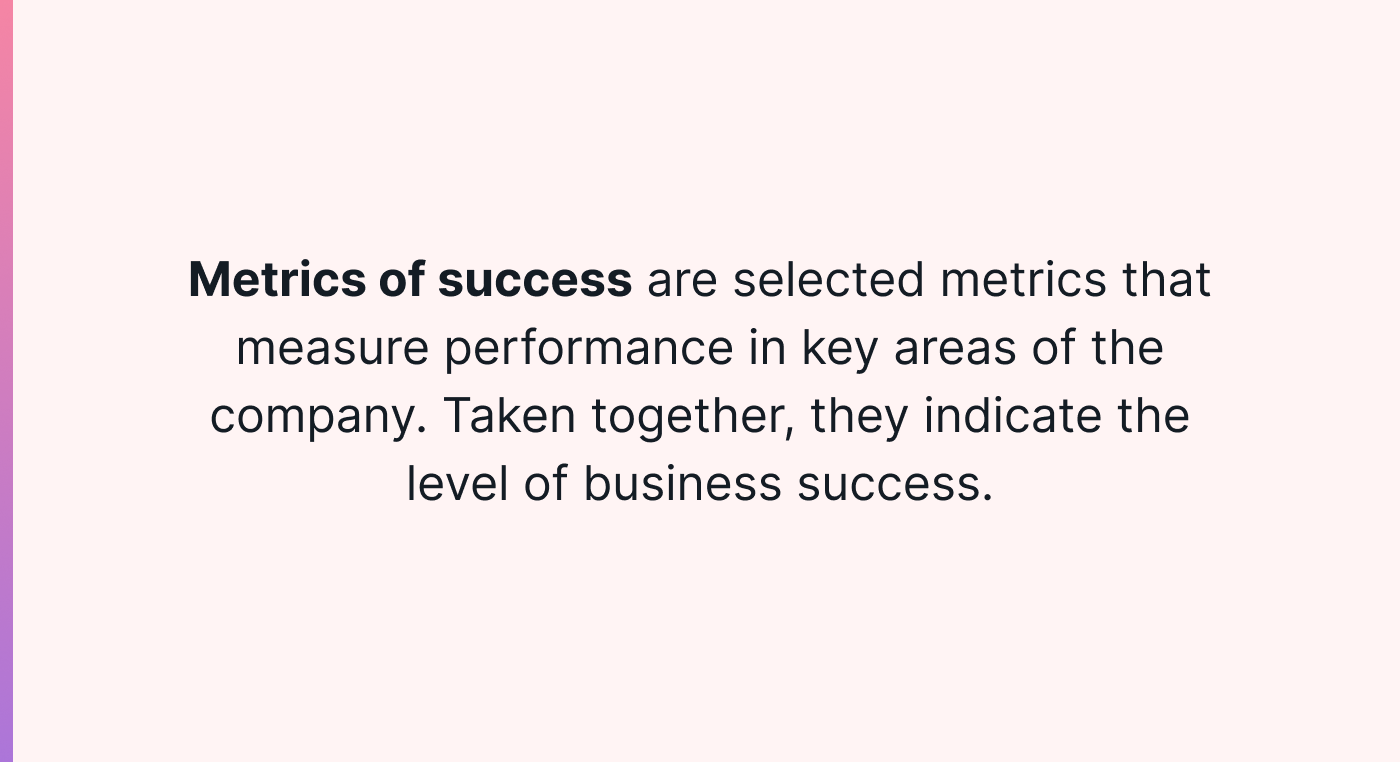 |
In general, success metrics or KPIs are quantifiable measurements.
They are directly linked to organizational goals and are used to measure performance against strategic and operational objectives. They highlight how effectively the organization is achieving its key business objectives, and they also communicate business health and direction to investors, board members, and other stakeholders.
Success metrics guide a company’s strategy — you can use them to ensure that business strategies align with desired outcomes.
Metrics of success are fewer in number than business metrics in general since they focus on the most vital areas of performance that drive success.
For example, a recent study of Swedish companies showed that 46% of their KPIs were sales-oriented, 30% focused on traffic and visits, customer satisfaction constituted 12%, and just 6% were focused on ROI. In other words, these companies realized that to remain successful, they needed to track sales figures and website visits instead of focusing solely on monetary returns.
Whereas general business metrics can cover both shorter and longer operational periods, success metrics are usually consistent over a longer time frame — unless the business strategy or goals change significantly.
The dynamic nature of success metrics
Even though success metrics focus on the long term, they are not static. Instead, they evolve over time as the business environment changes due to shifts in trends, markets, and technologies.
Success metrics also tend to shift with business phases. For instance, in a startup phase, the metrics that are used might focus on user acquisition, meeting startup milestones, measuring product-market fit, and staying on top of the cash burn rate.
During a growth phase, the emphasis could shift to measuring scaling and expansion, increasing the company’s market share, and improving customer retention.
Should a business be in decline or need to reinvent itself, the metrics could revolve around restructuring or exploring new markets.
How to choose the right success metrics for your business
Since not all businesses are the same, the general lists of metrics you find online may not necessarily be the best ones for you. Make sure to select the right ones to guide your growth and strategies.
Here’s a set of guidelines to help you make your selection:
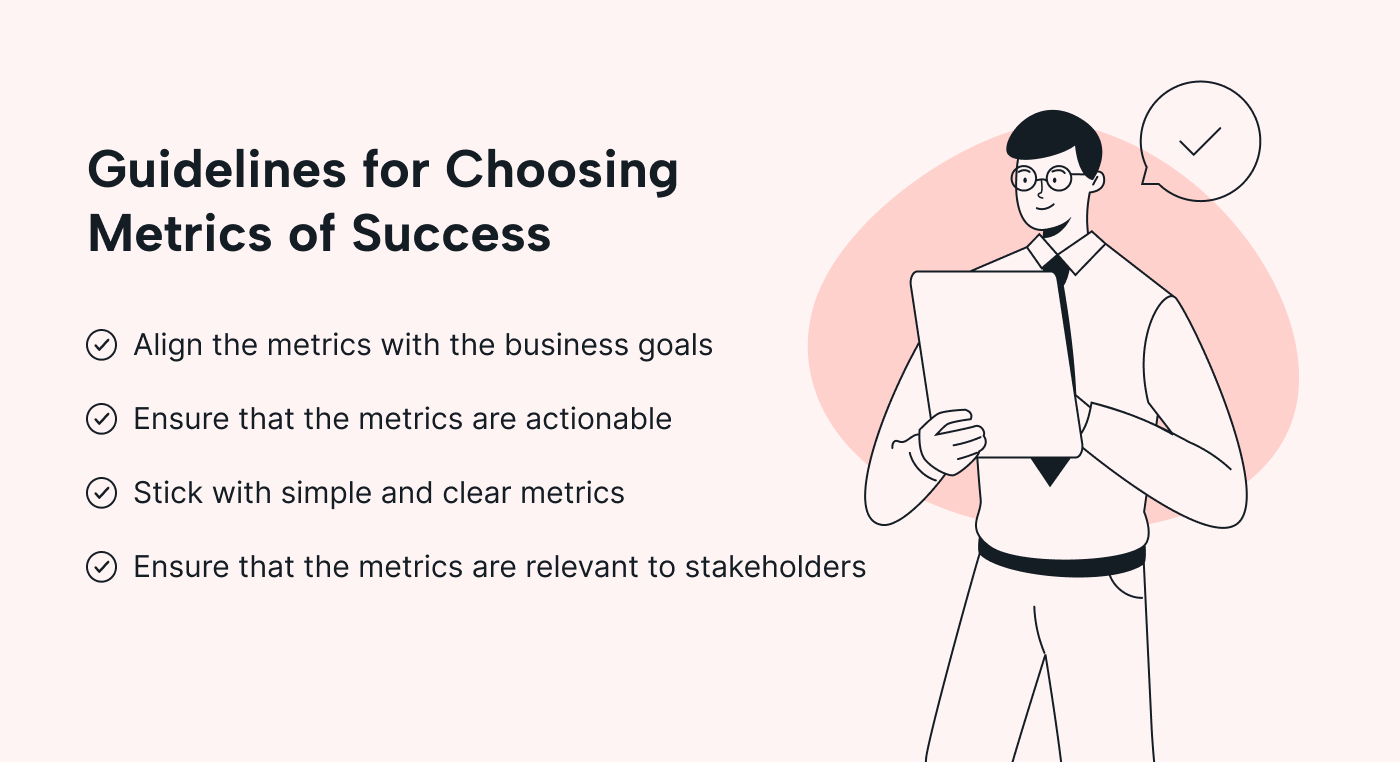 |
1. Align your metrics with business goals
Make sure that each metric ties back to a specific goal or target in your business plan, whether financial, operational, or strategic.
Cover both the most important immediate priorities (short-term) and the overarching visions (long-term) to build a complete picture of your business’s direction.
2. Ensure that the metrics are actionable
Prioritize metrics that offer clear insights for decision-making rather than just collecting raw data.
Metrics of success should suggest the next steps or areas of focus and be selected for their ability to drive decision-making. After all, success in any area becomes a catalyst for more success!
3. Stick with simple and clear metrics
Avoid overly complex metrics. The metrics should be easy for anyone in the organization to understand without requiring extensive explanations.
Also, watch out for ambiguity. Use clear definitions or descriptions in your metrics to make sure they aren’t open to multiple interpretations.
4. Ensure that the metrics are relevant to stakeholders
Keep your internal and external stakeholders in mind as you select your metrics.
It’s even a good idea to solicit input from your stakeholders as you formulate your metrics. That way, you can ensure your metrics resonate with their specific concerns and interests and that you offer meaningful, relevant data.
Your internal stakeholders, such as your marketing, sales, finance, and HR departments, may require distinct metrics that are relevant to their departmental functioning.
External stakeholders, such as investors, customers, and business partners, might be more interested in metrics like ROI, customer satisfaction, and partnership value.
Once you have your desired metrics identified, periodically evaluate and update them as your business needs change.
Key success metrics to track in business
In this section, we review 16 key metrics that matter in a business environment. They’re grouped into five sections that span the breadth of a business’s operations.
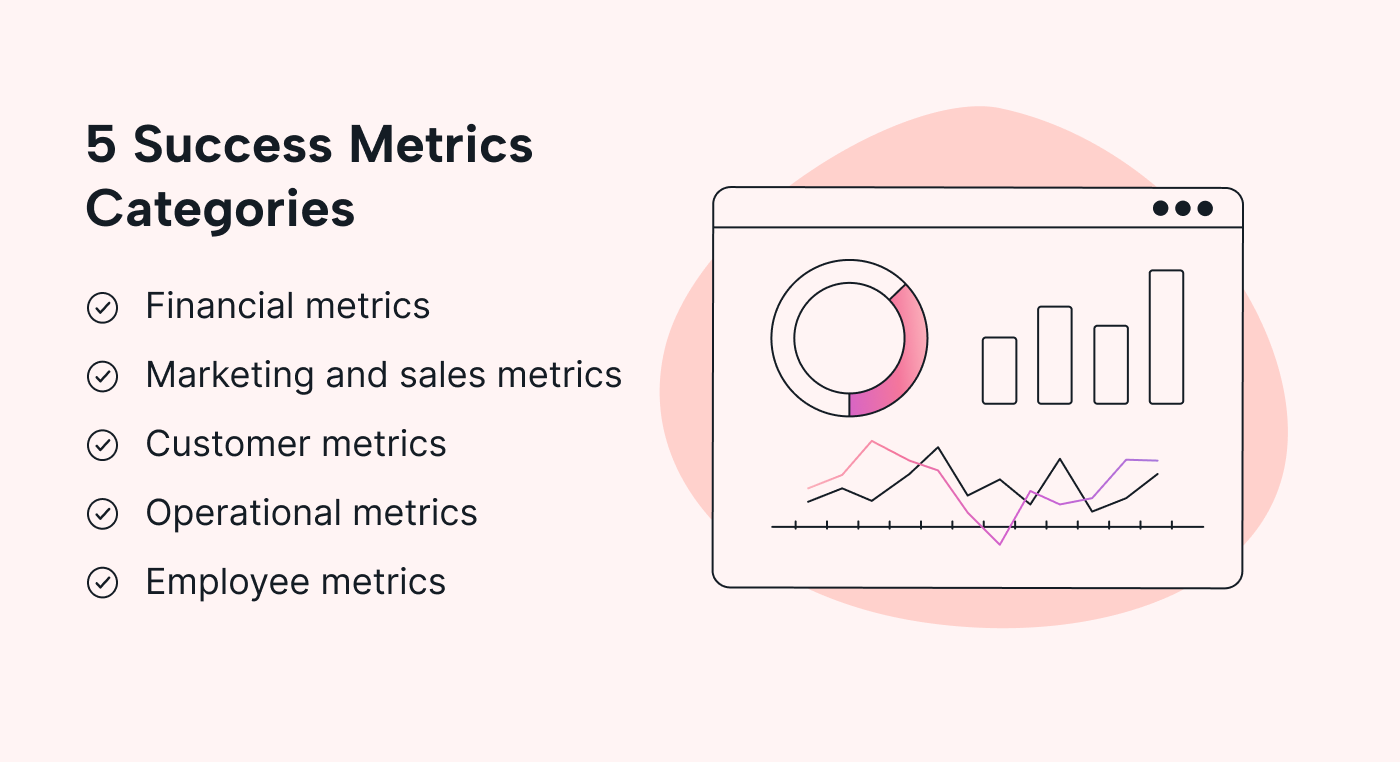 |
Paying attention to these metrics for your business will help you stay on top of — and continually improve — your operations.
Financial metrics
Profit margin: This metric gives you a clear snapshot of your company’s financial health by revealing how much profit is earned relative to revenues.
- Formula: Profit margin = (net profit / revenue) x 100
ROI: This metric gauges the effectiveness of an investment. It tells you the benefit obtained relative to the cost of that investment.
- Formula: ROI = [(final value of investment – initial value of investment) / initial value of investment] x 100
Liquidity ratios (or current ratios): These measure a company’s ability to cover its short-term liabilities with its short-term assets.
- Formula: Current ratio = current assets / current liabilities
Marketing and sales metrics
Conversion rate: This metric reveals the efficacy of your marketing efforts by showcasing the percentage of users who perform a desired action, whether it’s purchasing a product or signing up for a newsletter.
- Formula: Conversion rate = (number of conversions / total visitors) x 100
Customer churn rate: Keeping existing customers is just as important as acquiring new ones. Customer churn highlights the rate at which customers stop doing business or engaging with your company.
- Formula: Churn rate = (number of customers at start of period – number of customers at end of period) / number of customers at start of period x 100
Customer retention rate: The opposite of churn, this metric tells you how many customers are continuing to do business with you.
- Formula: Customer retention rate = [(number of customers at end of period – new customers acquired during period) / number of customers at start of period] x 100
Customer metrics
Customer acquisition cost (CAC): This metric represents the cost of acquiring a new customer. This can then be compared to how much value that customer brings to your company.
- Formula: CAC = Total cost of sales and marketing / number of new customers acquired
Lifetime value (LTV): This metric measures the total value a customer brings over their lifetime. It offers insights into the total revenue a business can reasonably expect from a single customer account.
- Formula: LTV = Average purchase value × average number of purchases × average customer lifespan
Net promoter score (NPS): This metric gauges customer loyalty and satisfaction. It categorizes customers as promoters, passives, or detractors based on their willingness to recommend your product or service.
- Formula: NPS = % of promoters – % of detractors
Operational metrics
Operational efficiency: This metric assesses the productivity of processes in relation to the resources used.
- Formula: Operational efficiency = output / input
Inventory turnover: This is an essential metric for businesses with physical products. It indicates how often inventory is sold and replaced over a specific period.
- Formula: Inventory turnover = cost of goods sold / average inventory
 |
Capacity utilization rate: This metric is used in manufacturing to determine how much of the manufacturing output capacity is actually being used.
- Formula: Capacity utilization rate = (actual output / potential output) × 100
Employee metrics
Employee satisfaction and engagement: This metric gauges staff’s morale and engagement levels. While it’s often measured qualitatively through surveys and other feedback mechanisms, you can derive an engagement score by taking an average of the positive responses.
- Formula: Employee engagement score = (number of positive responses / total responses) × 100
Productivity rate: This measures the output per hour employees work. It’s especially useful for production sectors.
- Formula: Productivity rate = total outputs / total inputs
Absenteeism rate: This metric provides insights into how often employees are absent from work.
- Formula: Absenteeism rate = [number of absence days / (number of employees × number of workdays)] × 100
Turnover rate: This metric measures the rate at which employees leave the company, whether voluntarily or involuntarily. A high turnover rate can be costly and affect company morale and operational efficiency, so it’s an important metric to stay on top of.
- Formula: Turnover rate = (number of employees who left during the measuring period / average number of employees during that period) × 100
Understanding these metrics and selecting the ones that best match the nature of your business equips your company with the tools to continually improve and refine its processes and output.
But remember: While metrics offer insights, it’s the actions you take based on those insights that truly drive success.
Using project management software to track success metrics
Did you know that modern project management platforms can help you better track your success metrics? That’s because, in addition to helping teams stay organized, they collect a treasure trove of data.
Once translated into actionable metrics, this data can be used to predict project outcomes, optimize the available resources you have, and, ultimately, drive business success.
Advanced project management platforms incorporate AI to predict project outcomes based on ongoing metrics so that company leadership can preemptively address potential challenges, as well.
Post-project metric analysis can offer insights for future projects, too. Your teams can identify what worked and what didn’t — and refine their strategies accordingly.
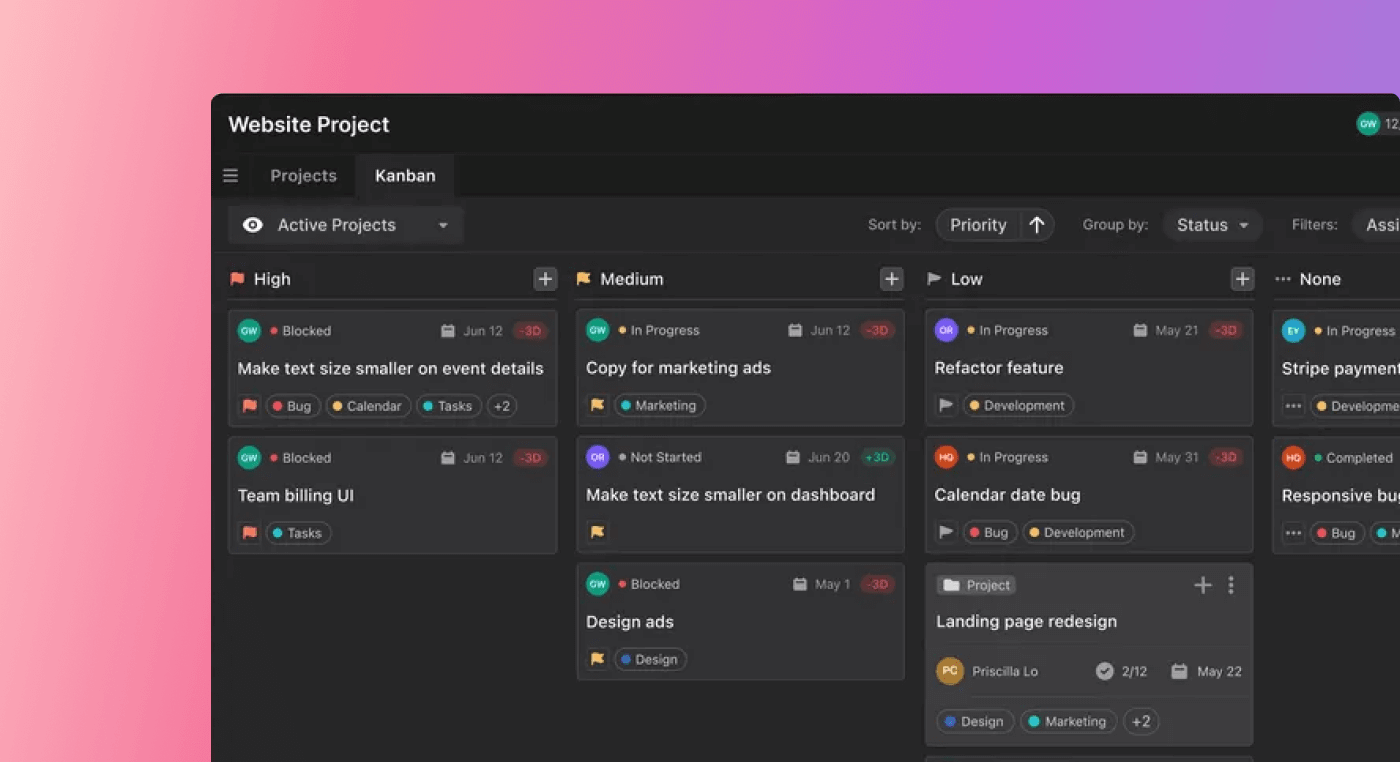 |
In essence, the convergence of project management platforms such as Motion’s AI-driven Project Manager with success metrics is revolutionizing the way businesses execute and learn from their projects.
Explore how project management apps can drive metric excellence
Business success metrics are dynamic tools that help ensure company health and growth. That’s especially true when they’re integrated with modern, AI-driven project management software, such as Motion’s Project Manager.
Check out Motion’s intelligent apps for yourself by signing up for a free 7-day trial.





